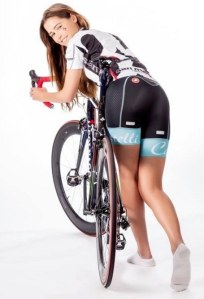
Companies have long used images of scantily clad, naked or simply strangely posed women to sell products, and the bicycling industry is no exception. Recently, the bicycle company Colnago has been criticized for images featuring women posed next to high-end bicycles posed in strange positions wearing impractical clothing. Colnago has since apologized, although it is yet to be seen whether the apology will lead to any meaningful change in their advertising.The advertisement has gotten enough attention that Bicycling Magazine and Cycling Weekly have both posted articles criticizing Colnago.

In the 1890s, bicycling companies– particularly French bicycling companies according to one source— sometimes uses illustrations of nude women to sell bikes, although “sexy” images of women on bicycles dates back much earlier. Earlier this year, Aaron Cripps briefly addressed the history of objectifying women in cycling advertisements starting in the 1890s on his blog Cycling History.

Advertisements in the 1890s often included illustrations of naked or nearly-naked who accompanied bicycles in impossible positions. For example, the figure in the Cycles Gladiator poster is flying along with the bicycle rather than actually riding it. The wings on the bicycle reference Hermes, the messenger god, who wore winged sandals, as does the nude figure who is meant to be an idealized archetype of a Woman, rather than any particular individual.

Although there were many advertisements during this period that were aimed at women, these certainly were not. The nude figures tend to be seen with men’s diamond frame bicycles, rather than the type of bicycle most women actually rode at this time. As the art historian T. J. Clark wrote in The Painting of Modern Life: “A nude, to repeat, is a picture for men to look at, in which Woman is constructed as an object of somebody else’s desire.” Her main purpose is to be desirable.

In the case of some of the posters one could make the argument that they are art– or at least that there is artistry and imagination in their creation. Granted, if the artists were alive today I might be tempted to comment on the unlikelihood of flying next to a bicycle naked or standing on the saddle while dressed in gossamer fabric, but I don’t think they were trying to be all that literal. The French posters may have been referencing Marianne, a symbol of the French Republic who is a form of Lady Liberty. The images imply that riding a bicycle is liberating, while also providing an excuse to display a nude figure.
So what exactly is the problem with companies using sexualized images of women now? The women are actually wearing more clothes than their 19th century counterparts and it can hardly be argued that models are generally a realistic representation of how people look everyday. It’s also safe to say that women in the nineteenth century often weren’t taken seriously as human beings– if they even were considered human beings– and that replicating nineteenth century ideas is probably not the most forward thinking thing to do.

For me, and apparently for other cyclists as well, the advertisements are so infuriating because they suggest that women aren’t serious cyclists and shouldn’t be taken seriously as potential bike customers. Instead, they imply that the company believes they will sell more bikes if they put them next to attractive women, as if the purchase of a bike includes (at no extra cost!) an attractive woman. As if it were common to ride a road bike while high-heels or socks. It’s fairly clear that these are not some kind of innovative clip-less compatible socks, as we can see that there are no cleats on the bottom of her feet.
The issue isn’t what individual women choose to ride in. The images feature models who are posing, not candid shots of women with their own bikes. If a woman wants to attempt to ride in heels, well, that seems like an uncomfortable choice, but I am sure it has been done (although most likely not too often on a bike like that). Other bike companies manage to have advertisements that show women actually riding bikes, or fixing their own bikes. I regularly see women riding in everything from mini-skirts to commuter pants to cycling kits. But you know what I have never seen once in real life? A woman standing next to a bike with her butt in the air while she glances over her shoulder while dressed in socks.
